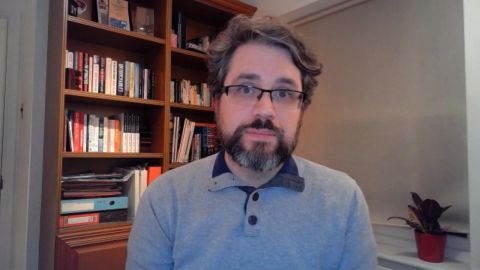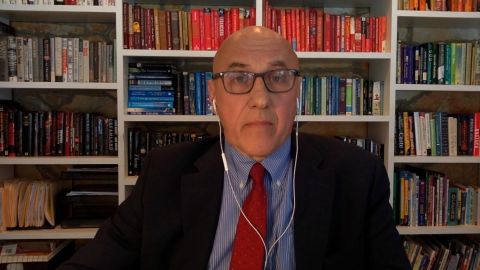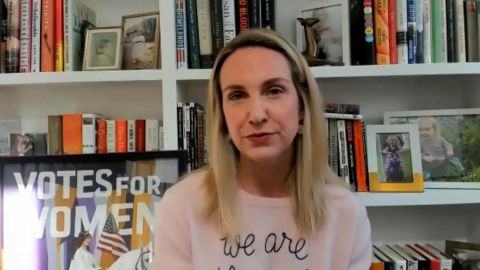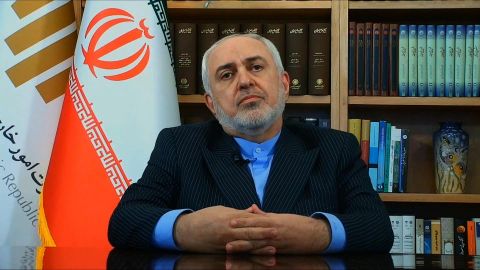Read Transcript EXPAND
CHRISTIANE AMANPOUR: Turning now to a newsroom made for our times. The 19th* is a nonprofit website that covers gender, politics and policy. It’s named after the 19th Amendment which gave American women the vote in 1920, at least most of them. From child care to jobs to voter suppression, it covers the issues that are pivotal to everybody, especially women of color and the LGBT community. Here is the CEO and co-founder, Emily Ramshaw talking to our Hari Sreenivasan about the project amid a pandemic that’s hitting women so hard.
HARI SREENIVASAN: Christiane, thanks. Emily Ramshaw, thanks for joining us. One of the first big stories that you came out with was called she-session. And that right around the time that the pandemic was coming in, people had anecdotal stories of how this was disproportionately affecting women, but your site was one of the first places to really dive deep in on this. And sadly, we are nowhere close to evening that out or improving that situation. It has still continued throughout the pandemic.
EMILY RAMSHAW, CO-FOUNDER AND CEO, THE 19TH*: Absolutely. I mean, this is the truly like the first women-specific recession in American history. And, you know, we can go through what some of those numbers look like, but the reality is, women were the ones who held the majority of jobs that were lost in this pandemic, women also were the ones disproportionately affected by immediate erosion of child care and the access to in-school education. And so, as a result, women and in particularly women of color have been hit in an extraordinary way. I mean, I think there are a lot of folks who believe it’s going to take a generation for women to get back on track with the losses that we have seen.
SREENIVASAN: And it took a generation even just to get up to this point and how fast some of the gains have been given back if you are talking about so many women having to choose between continuing a job or trying to provide child care at home.
RAMSHAW: Absolutely. I mean, if you think about the height of this pandemic. So, you know, back in the spring, there were 12 million women who had lost their jobs. You know, we have not even recovered half of those jobs at this point. If you look at the most recent jobs report in December, I mean, the numbers are still really harrowing. You know, we just have not made the strides back. I think, you know, among the Latina women, 9 percent are unemployed. I mean, these numbers are sky high. And in this moment, where we have seen this renewed resurgence, numbers are almost as bad as they were, you know, several months ago. So, this is a harrowing moment.
SREENIVASAN: Is this because of the roles that women are playing in the workforce today? I mean, when you look at particular professions say for — in classrooms or in nursing as a profession, probably 3 out of 4 of either of the occupations are women. But why it so disproportionate that so many women are losing their jobs?
RAMSHAW: Right. You know, when you look at the industries that have been hardest hit, those industries tend to be powered by women. So, whether it’s the service sector, which is powered by women, you know, whether it’s education, jobs and education and child care, which have been supremely hard hit, you have seen enormous job losses in these arenas. You know, you’ve also had women at the frontlines, by the way of, you know, health care, nursing. So, you know, whether they are losing their jobs on one end or sort of thrown head-first into the fire, on the end, they’re been hit super hard. But I think the flip side of this, as we all know, that women still overwhelmingly bear the burden of both child care and elder care, the sandwich generation of trying to care for your children and keep your parents alive, and, you know, this is — thrown all that into full relief in this moment in history. But as you have seen, you know, kids home from school in enormous numbers, as you have seen, you know, childcare centers I think there’s some — I saw some statistic that like half of childcare workers have been laid off during the pandemic. That means that parents and in particular mothers have been left to make this really difficult choice, you know, do I stay in the workforce or do I have to stay home care for my child, and so many, so many are having to leave the workforce.
SREENIVASAN: I don’t know if it’s our willful ignorance of this, but there are so many more people aware of how important child care is to the functioning of an entire economy. Like, right now, we have policymakers thinking about, OK, we need to get the children back into school, because, guess what, if the kids aren’t in school, the parents aren’t going to be productive, they can’t go to work, et cetera, et cetera. But it’s sad that it took a pandemic to make us realize the importance of this function in society.
RAMSHAW: Yes. You know, I would say, women have been talking about this for a very long time and, you know, folks at the highest levels of government just haven’t been listening. But the reality is, other countries are far ahead of the United States when it comes to things like paid leave. The United States is the only country, you know, in the free world where there is no semblance of assured paid leave. You know, I think that child care, certainly, affordable child care, access to child care has been an enormous problem for years. Child care deserts are a supremely giant problem, the cost of child care. You talk to any parents, so many women drop out of the workforce because it is more expensive to keep their child in child care than it is to care for them at home, they can’t make up the difference in their careers. And so, this has been a problem for generations, for decades, certainly, and it has taken this pandemic, I think, really to throw it into full relief and front and center in the public eye.
SREENIVASAN: It is hard enough to get a new website or publication launched, but then to do it at the beginning of the pandemic, you just kind of really seem like you wanted to up the odds against your success here, that seems to be an incredible undertaking. Tell me a little bit about what it is like to start a new site, go out and fundraise, go out and hire the staff, do everything right around the time when corporate underwriting could disappear to nothing, some of your funders might be hesitant.
RAMSHAW: I will tell you, this has been the hardest year of my life, certainly, and many others. But, I think, if you had told me that a year ago that I would be launching a startup focused on gender, politics and policy in the middle of a global pandemic, in the middle of a racial reckoning, hopefully, a modern-day civil rights movement, you know, I’m not sure I would have taken that giant risk. The reality is, you know, there were a lot of tearful moments at the dining room table trying to figure out if we were going to even make this happen. But we realized pretty quickly, even as our fundraising was drying up in the winter, that this was a moment that was going to disproportionately affect women and other marginalized people, particularly women of color, and that we had a moral obligation, honestly, to jump in head-first. So, we are a year in, you know, amazingly, we have hundreds of thousands of people reading our site every month, tens of thousands of people subscribing to our newsletter. More than 200,000 people have come to our events and, you know, 10,000 early members who are making this a reality for us. So, yes, it has been really hard, but this moment in history feels so critical and we are so grateful that we have been able to launch The 19th* in this particular year.
SREENIVASAN: Why did you need to exist given all of the publications that exist today? Why is there not the type of focus that you are bringing to it?
RAMSHAW: Sure. I mean, look, the reality is — and you know this well. I mean, I think the majority of American newsrooms in the politics and policy sphere are — they’re overwhelmingly run by men, white men, you know, you see that at the reporting level, you see that at the managerial level, and I think a lot of reason that you have seen that is that women opt out of this industry at a particular point, because the salaries aren’t high enough, the benefits aren’t good enough, and the child care reality is, you know, the news cycle is not conducive to trying to have small kids at home. I mean, we all know that. I experienced that firsthand. I’ve got a 5-year- old. And so, our vision was to see if we could create both an atmosphere where we could change the national narrative around gender, politics and policy, around how women are presented in the news by building a newsroom that was truly representative of the nation’s women, and the LGBTQ community. So, that’s what we’ve worked to do this last year, and, you know, I’m really proud of where we are today.
SREENIVASAN: What kinds of steps did you take to make sure that the environment that you were creating, building from scratch was not only more productive, but also more rewarding and more humane?
RAMSHAW: We started with offering the kind of benefits that none of us had seen in any other newsrooms in America. So, you know, from the ground floor when we were fundraising to build this, we built this into our brand and our value proposition and our budgets. Six months of fully paid family leave for all new parents. Four months of fully paid care giver leave. So, you would not be penalized for spending the past several months of your mom or dad’s life at their lives. You know, 100 percent coverage of health care premiums, a 401(k) match. And the ability, honestly, to work completely remotely. This is pre-COVID, to work wherever you had the best child care and elder care set up. So, I mean, my vision is, you know, can we advance more women into news leadership and in particular, more women of color into news leadership by giving them the support systems they need at that sort of critical sandwich general moment in their lives to get past that. I mean, I am the child of two journalists, right. My mom was in middle to upper management as a journalistic in my, sort of, you know, formative years, and the days were long. I mean, you know as well as anybody else what political journalism is like, you know, the need to have your body in the chair in a newsroom, in a desk 8:00 a.m. to 8:00 p.m., that’s really, really tough when you are trying to balance family, when you’re trying to take care of elderly relatives. So, all of those things were big priority for us. And certainly, they came into full relief during the pandemic when we had folks needing to take advantage of those leave policies, when we had colleagues whose parents, you know, died of COVID, when many of us were stuck with small children at home, you know. If we proved that we can launch a startup like this in a pandemic with those kinds of benefits, I think those kinds of benefits are feasible and should be instituted everywhere.
SREENIVASAN: In a way, your staff ended up contributing through their own lives and the lives of their peers to the exact type of stories you’re talking about, the challenges that they’re facing in their real lives are the ones that you’re helping kind of distribute to a wider audience about what is happening.
RAMSHAW: Absolutely. And I think, you know, one other element of that is, you know, we are talking about the pandemic here, but also have had, again, a moment of racial reckoning in this country, a summer that was — has sparked a whole lot of really critical conversations, and we’re also a newsroom where we encourage our colleagues to bring their full lived experiences into the workplace. And so, you know, Errin Haines on our team was the first national reporter to tell the Breonna Taylor story, and, you know, obviously, that was a landmark moment and a really important story for this nation. We’ve had a lot of moments like that where we are really devoted to ensuring that we are telling the full story. And by the way, having a newsroom that is fully independent and says there are also things we stand for. We stand for gender equity. We stand for racial equity. We stand for human rights.
SREENIVASAN: Why do you think that the Taylor family chose to tell her story to your publication?
RAMSHAW: I know why they chose to tell the story to our publication and said they thought that the stories of black men who were wrongfully killed by police were getting more attention in the national media than the stories of women who were being wrongfully killed by police. And so, they came to us and their lawyer came to us with that particular lens in mind, and I think they were right on that account. You know, that story got picked up far and wide. It — you know, I think in many ways Breonna Taylor’s care reignited the “Say Her Name” movement. It became a flashpoint in this just really critical point in history. And they came to us with that gender lens front and center.
SREENIVASAN: What do you think the Biden administration has to do? How quickly do they need to move in order to hear the concerns of so many women and people of color who voted for the Biden administration, who think that family leave is important, who think that child care is important? What kinds of steps does the administration have to take?
RAMSHAW: You know, I think there are going to be a lot of people who are looking to hold this administration accountable because, you know, they have been very adamant and very clear in their demands and what is needed this moment in history. And so, I think, you know, you’ve already seen it. If this rescue plan of Biden’s comes to be, you know, you will see conversations around increasing the minimum wage, which would disproportionately affect women who are in those low wage jobs, you know. Bolstering child care, you know, instituting expanded paid leave, you know, providing rent relief. So many of those things, you know, directly affect women and hit women of color hardest of all. And so, I do think you’re going to see a lot of demands, a lot of attention spent in these particular areas and a lot of really high expectations that given his potential in this moment with both chambers of Congress and also with executive orders that he can take pretty serious and swift action.
SREENIVASAN: Have you spoken to members of the administration or the comms team, so to speak? I mean, they are primarily women-led and you have the Biden administration come in, already say, look. Look at the number of female nominees for cabinet positions, that’s certainly a massive reversal from what it was in the last four years. How do you make sure that it’s not just a numerical checklist and that make sure that the voice of these women and people of color are represented in the administration in a more forceful way?
RAMSHAW: Yes. So, we’ve been really front and center and reporting on and sort of providing, I think, a level of accountability for, you know, OK, this is what you said you’re going to do, who are these people who are in the administration and what are their roles? We had a live event a couple of weeks ago where we interviewed the four women who are leading the Biden/Harris comms team. It was a fascinating conversation just to hear from them both in the standpoint of the work that they are intending to do and how they’re trying to rebuild trust with the American public. You know, what is it like being women in these particular roles, and particularly, having, you know, small kids. And so, that was a fascinating conversation that — if you’re viewers haven’t seen it, I’d encourage them to. You know, I think the people who are on the really frontend of Biden’s health care initiatives, many of them are women, you know, many of the top officials who are nominated are women. You know, the deputy health director who he has nominated is — would be the — I believe, the first transgender official in these appointed offices. And so, we are keeping a very close eye on those conversations. But this isn’t just about having women in appointed positions in an administration, it’s about normalizing it, it’s about making sure you’re not just asking the questions about, what’s like to be a woman in this particular role, but normalizing that leadership and asking them the same tough questions and accountability driven questions that you would ask a man in that role.
SREENIVASAN: One of the things that we have also seen in this time is the effect of misinformation and disinformation, and we can see as it comes vaccine (INAUDIBLE), for example, there is still a pretty massive inequity in terms of who is getting the vaccines and also, who has access to good information about the vaccines to make up their own minds. What kinds of things are you doing as a newsroom or as reporters, what kind of story, ideas are you talking about around this?
RAMSHAW: Absolutely. So, I think, you know, one other thing in this arena that’s really important to recognize is that women tend to be the ones who are making medical decision, health care decision for their households and families, and women are also subject to really specific misinformation and disinformation. I mean, we’ve written a lot about the different ways that women can fall prey to this misinformation even on places like Pinterest. And so, we are focusing pretty seriously on telling the stories of women at the forefront of vaccine research, of people who are doing the work to target of this information. We’re going to be hosting a really specific symposium aimed at women and misinformation and how we sort of battle that as a nation. So, I think, we are paying very close attention to that line of storytelling. And also, specifically, the ways that communities of color may not be getting the full story or are, you know, concerned about vaccine science and the ways that they have been marginalized in health care in the past, you know, we’re talking to folks about the way that the Latinx community has been targeted for misinformation in Spanish. So, lots of conversations, again, you know, for us to, the asterisk speaks about people who have been left out of our democracy. And this is a moment when, candidly, we can’t afford for anyone to be left out.
SREENIVASAN: Where is that gap in terms of people left out? How far have we come? How far do we have yet to go?
RAMSHAW: Look, I mean, it’s interesting, when we think about of The 19th* itself, you know, we’re named for the 19th Amendment. But the reality is, the 19th Amendment gave white women the right to vote, and it was another four decades well into the civil rights movement before any women of color had access to the votes. And even then — you know, from then, basically to the present day, we continue to see voter suppression that has hit communities of color the hardest. You know, we also write a lot about the gaps that have kept trans Americans from getting access to the polls. Issues around, you know, IDs and, you know, making sure that you’re able to access the polls with your true name and your identity. And so, I think, this is all a work in progress, this asterisk in our logo, which is what the center of what 19th does is, you know, democracy still is only available for some of us, and we need to work really darn hard and in particular in this moment in history to ensure that we are leveling the playing field and bringing more people to the table.
SREENIVASAN: Emily Ramshaw of The 19th*, thanks so much for joining us.
RAMSHAW: So happy to be here.
About This Episode EXPAND
Javad Zarif; Tom Andrews; Eliot Higgins; Emily Ramshaw
LEARN MORE



